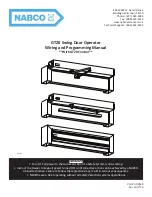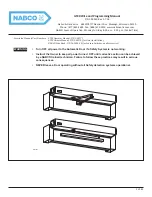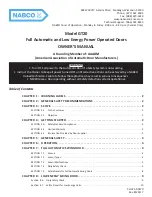
Duct and Duct Connections
(refer to design drawing)
•
4 x 125mm spigots are provided for the connection of ducting. These are clearly marked for correct connection of the
supply and exhaust ducts.
•
Where ducting is installed in an unheated space, all of the ducts should be insulated. Where ducting is in stalled in a heated
space, only the cold ducts should be insulated. i.e. the supply duct from outside and the extract duct from the unit to the
outside.
•
The duct layout must be designed to suit the requirements of the ventilation/recovery system and building layout. If the
ducting passes through a fire wall/barrier, suitable fire dampers must be installed.
•
Where rigid duct is used (preferable), it should be installed using the least number of fittings to minimise air flow resistance.
Where possible, final connection to the grilles and unit should be made with a flexible connection.
•
Where flexible ducts are used, ensure that:
- duct runs are kept as short as possible
- the duct is stretched so that it is smooth and straight
- where bends are necessary, they have large radii (ie avoid sharp bends)
- the duct is not crushed if in a restricted area
Condensation
(The unit may sometimes produce condensation which must be drained away. A 15mm dia pipe connection is provided on
this unit).
•
A 15mm dia pipe must be fitted to the pipe connection. If any part of the condensate drain is in an unheated space it
MUST be insulated with the equivalent of at least 25mm of insulating material with a thermal conductivity of 0.04 W/(mK).
•
The pipe must drain into the normal household drainage system.
•
The drain must incorporate a wet or dry trap to prevent air penetration.
•
The unit must be tilted towards the side carrying the condensation exit point. It should be installed horizontally with a
3º tilt towards the condensation drain used (equivalent of raising the opposite end by approximately 30mm).
•
The drainage pipe must have a continuous fall from the unit to the drainage collection point.
Electrical Connection
WARNING: these appliances must be earthed and all wiring must conform to current IEE Regulations and all applicable
standards and Building Regulations.
• The unit is suitable for 230v-240v, 50Hz: Consumption - 0.92Amps
• The unit is supplied with:
-
A mains rated 4 core flexible cord (black, brown, grey, green/yellow)
-
An optional factory-fitted 2 cord volt-free flexible cord for purge switching
• A triple pole isolation switch with contact separation of at least 3mm must be used to connect the appliance to the
fixed wiring when using the Switched Live.
• Boost controls must not be located within 1 metre of a cooker or where they may be affected by excessive heat or
moisture
• Boost controls should be clearly identified and conveniently located.
• The boost switch wiring cable access is via a 12mm cable gland.
• The boost speed can be activated by a switched live connection from a variety of external devices including:
- PIRFF (passive infra red)
*
- DRH240 (dynamic remote humidistat)
*
- THM (thermostat)
*
- a light switch (if more than one light switch is used,
each one must be a double pole switch)
- a remote switch/pull cord
or via LCD control panel
(
*
PIRFF, DRH240 and THM may have integral over-run timer which controls the length of time that the fan will continue to
operate at its boost speed after the boost has been switched off.)
Commissioning
•
When the unit is set up and running, the minimum setting on the speed control switch must relate to the designed volume
air flow. The variable air flow from minimum to maximum allows the unit to extract a greater volume to cope with any in
crease in the build up of condensation or foul air, ie cooking etc.
•
Before starting the commissioning procedure, refer to the design drawing for correct air flows.
•
Installation of the appliance
MUST
be carried out by a qualified and suitably competent person and should be carried out
in clean, dry conditions where dust and humidity are at minimal levels. It should only be installed after other building works
have been completed and the building in which it is installed cleaned. Failure to comply with any of the above points will have
an impact on the validity of the guarantee.
•
Prior to starting the commissioning procedure, ensure that the ductwork connections and airflow directions are as marked
on the product.
•
Before making any adjustments, ensure that the air valves or grilles are fully open.
• Please see separate "LCD Control Panel Installer Instructions" for details on commissioning and user
operations
.
WARNING : With the control board panel removed, 230 volt live connections are accessible.
Page 4























